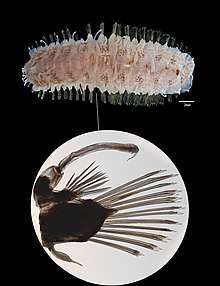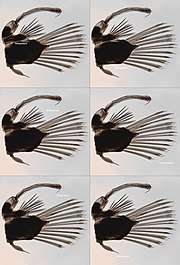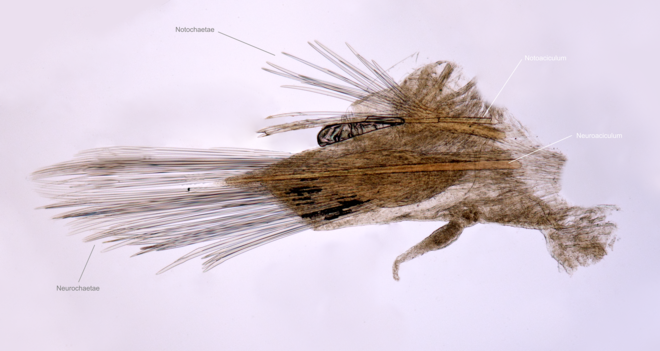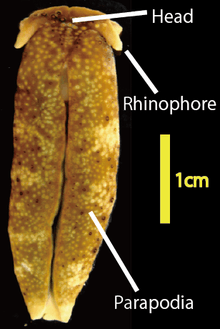Parapodium
In invertebrates, the term parapodium (Gr. para, beyond or beside + podia, feet; plural: parapodia) refers to lateral outgrowths or protrusions from the body. Parapodia are predominantly found in annelids, where they are paired, un-jointed lateral outgrowths that bear the chaetae. In several groups of sea snails and sea slugs, 'parapodium' refers to lateral fleshy protrusions.

Annelid parapodia


Most species of polychaete annelids have paired, fleshy parapodia which are segmentally arranged along the body axis. Parapodia vary greatly in size and form, reflecting their variety of functions, such as gas exchange, anchorage, protection and locomotion.[1]
General description
Parapodia in polychaetes can be uniramous (consisting of one lobe or ramus) but are usually biramous (two lobes or rami). In the latter case, the dorsal lobes are called notopodia and the ventral lobes neuropodia. Both neuropodia and notopodia may possess a bundle of chaetae (neurochaetae and notochaetae respectively), which are highly specific and greatly diversified. A single stout internal chaeta, called an acicula, may be present in each lobe, which are used to support well-developed parapodia. Notopodia and neuropodia can also bear cirri which are tentacle-like projections of the parapodia. In some groups, such as the scale worms (e.g. Polynoidae), the dorsal cirrus is modified into a scale (or elytron). [2]
In most species, the anteriormost segments may be specialised into the head region and prostomium, which can result in the modification of those parapodia, loss of chaetae and elongation of the cirri into anterior-facing tentacular cirri.
Glossary of components of the parapodium
| Component | Description |
|---|---|
| Dorsal cirrus | Cirrus extending from the notopodium; can be modified into a scale (or elytron) in scale worms. |
| Neuroaciculum | Stout internal supporting chaeta (acicula) for the neuropodium |
| Neurochaetae | Chaetae of the neuropodium |
| Neuropodium | Ventral lobe |
| Notoaciculum | Stout internal supporting chaeta (acicula) for the notopodium |
| Notochaetae | Chaetae of the notopodium |
| Notopodium | Dorsal lobe |
| Ventral cirrus | Cirrus extending from the neuropodium |
Gastropod parapodia

The fleshy protrusions on the sides of some marine gastropods are also called parapodia. They are particularly well-developed in sea butterflies. Some sea hares use their parapodia to swim. Parapodia can even be used for respiration (similar to gills) or for locomotion.
Parapodia are found in the following taxonomic groups of gastropods:
- Clade Cephalaspidea
- Clade Thecosomata
- Clade Gymnosomata
- Clade Aplysiomorpha
See also
- Epitoke parapodium
- Annelida
References
- Rouse, Greg; Pleijel, Frederick (2001). Polychaetes. Oxford: Oxford University Press. ISBN 0198506082.
- Hutchings, P. A.; Fauchald, K. (2000). Polychaetes and Allies: the Southern Synthesis - Class Polychaeata: Definition and General Description. Melbourne: CSIRO Publishing. pp. 1–3.